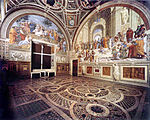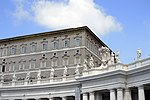St. Peter's Square

Saint Peter's Square (Latin: Forum Sancti Petri, Italian: Piazza San Pietro [ˈpjattsa sam ˈpjɛːtro],) is a large plaza located directly in front of St. Peter's Basilica in Vatican City, the papal enclave in Rome, directly west of the neighborhood (rione) of Borgo. Both the square and the basilica are named after Saint Peter, an apostle of Jesus whom Catholics consider to be the first Pope. At the centre of the square is an ancient Egyptian obelisk, erected at the current site in 1586. Gian Lorenzo Bernini designed the square almost 100 years later, including the massive Doric colonnades, four columns deep, which embrace visitors in "the maternal arms of Mother Church". A granite fountain constructed by Bernini in 1675 matches another fountain designed by Carlo Maderno in 1613.
Excerpt from the Wikipedia article St. Peter's Square (License: CC BY-SA 3.0, Authors, Images).St. Peter's Square
Via Fontenelle,
Geographical coordinates (GPS) Address External links Nearby Places Show on map
Geographical coordinates (GPS)
| Latitude | Longitude |
|---|---|
| N 41.9022 ° | E 12.4572 ° |
Address
Piazza San Pietro
Via Fontenelle
00120 , Vatican City
Vatican City
Open on Google Maps








